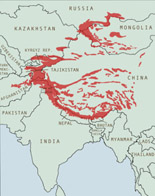Researchers recently announced that snow leopards have been found in the Saylyugem National park, which was created five years ago to protect wildlife in the Altai mountains of Siberia.
The photos were taken by remote camera traps and are the very first to show that the snow leopard is calling this national park home.
This is particularly heartening news at a time when Russia’s snow leopards appear to be in decline due to poaching and habitat loss.
‘Our scientific research began in February and in less than a month we got the first photos,’ said Aleksei Kuzhlekov, a local researcher. ‘The snow leopard was spotted four times, at different times. It is difficult to say though how many were caught by cameras, whether it was one or two.’

The Saylyugem National Park was created five years ago to protect endangered wildlife. It was not known that snow leopard inhabited the area. Photo by Saylyugem NP.
Another senior researcher, Sergey Spitsyn, said the videos and images could be of three or four different leopards. ‘Two of them were in footage and they have different patterns on their tails. The others were captured on the photo cameras, but it’s hard to tell if there are any different patterns because of low quality of the photos.’
The National park was created five years ago to protect wildlife such as the argali mountain sheep and the area now totals 118,380 hectares. It was not known that snow leopards were in the area but now that argali are protected they will attrack snow leopards for whom they are a major prey source. The protection of the National Park was seen as important to protect both argali and snow leopards. Unfortunately poachers had killed more than 10 snow leopards in the area during the 1990s and their furs and body parts would have been sold on the black market for Chinese medicine.

The remote beauty of one of Russia’s most recent national parks which has now been found to have snow leopards. Photo Saylyugem National Park.
The head of the local conservation department, Igor Ivanitsky, adds: “We were able to place the cameras in the right place by painstakingly working out the movements routes of the cats.
“Being then so successful with our camera trapping efforts tells us that the park is their main home and hunting ground.
“Park staff have also found snow leopard tracks and scats (droppings) in several places around the national park, giving further evidence that the big cats are thriving in their newly created refuge.”
The park’s researcher, Alexei Kuzhlekov, said, “The research project was launched in February 2015. We used standard methods for studying snow leopards. After completing our research, we installed camera traps along presumed snow leopard migration routes. It took us less than a month to photograph the first snow leopards. We took four photos of a snow leopard at different times. So far, it’s hard to say whether we have taken photos of one or two snow leopards.”

Saylyugem National Park has conditions faboured by snow leopards. The cats may thrive now that the national park offers them protection from poachers who have killed at least 10 snow leopards in the last 20 years. Photo Saylyugem National Park.
Dr. Matthias Hammer, Executive Director of Biosphere Expeditions, which assisted in the creation of the new National Park says he is delighted with the news.
“We spent ten years working in the Altai, researching snow leopard presence, building local capacity and trying to create economic incentives for local people to keep their snow leopard neighbours alive.
“When we started, there was no national park, little awareness, research or infrastructure, and rampant poaching.
Now the park’s researchers, scientists and colleagues from the Altai Reserve will work on visual comparisons of the snow leopards in the photos with those listed in the their database to establish the exact number of cats and identify individuals. We wish them all the best for their work with this snow leopard group and may the snow leopard population here be safe and grow.





Comments on this entry are closed.